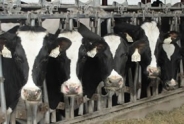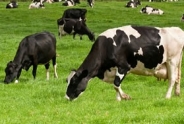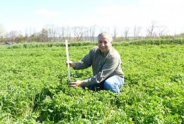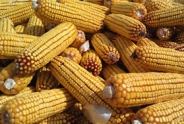First Cutting Updates - Week of May 8th, 2018
Betsy Hicks, Area Dairy Specialist
South Central New York Dairy & Field Crops
The team has spent the last two days gathering alfalfa heights around the region to give information about targeting first cutting. See the attached report for fields in Broome, Chemung, Cortland, Onondaga, Tioga, and Tompkins counties.
Comments from Janice Degni, SCNY Field Crop Specialist:
"For the most part younger alfalfa stands came through the winter well. In the fields that we've checked with 50 percent or less alfalfa the alfalfa is less vigorous and growing much more slowly. This year there is lot of variability of growth within the field. We measure the tallest stems, but there can be as much as 2 inches of difference in the stems from the same taproot or nearby plant. The stands on heavier soils are coming a little more slowly. We see the mix of winter annual weeds, for example chickweeds and purple deadnettle. Dandelions are in bloom. I've seen a little alfalfa weevil feeding, which appears as notches in the leaves. It's something we will keep an eye on. Usually first cutting breaks up the insects' life cycle and there is no need for treatment.
Don't be caught off guard by grass stands. Grass is growing quickly. Many alfalfa stands measured close to 12" this week. If the target height for harvesting clear grass stands is 14" you should be watching them closely. The predicted warm days will quicken their pace to boot stage. We have a little leeway with mixed stands with harvest targeted at 22 inches of alfalfa height. For clear alfalfa we are looking for 28" of growth."
An overall assessment of first cutting growth from fields we measured:
Many stands of alfalfa are too short to give adequate predictions for pure grass stand harvest - especially those at higher elevations. That being said, many lower elevation fields have alfalfa measuring 11-12", and predictions for harvest of nearby pure grass fields look like this weekend for peak quality. 50/50 mixed grass/alfalfa stands predictions are saying harvest in ~2 weeks, but time and weather will give us a better prediction next week for mixed stands. Weather looks like rain on Saturday, but a decent stretch of weather to start next week out. Look for our next report on Wednesday, May 16th. In the meanwhile, stay safe out in the fields and update the team with any conditions you encounter that would be of interest.
Alfalfa height has been proven to be a reliable indicator of NDF values in the field for alfalfa, alfalfa/grass mixed and all grass stands. Results will be compiled and posted/sent out on a weekly basis. To receive weekly email/text updates, please contact us at 607.391.2673 with your preference of email or cell phone number and mobile carrier. The email will contain the report as an attachment, the text update will contain a link to view the report on our website. To be removed from this list, email Betsy at bjh246@cornell.edu.
The numbers that are indicators for using alfalfa heights for NDF content are as follows:
• 100% grass stands should be cut when nearby alfalfa is 14 inches tall, to achieve 50% NDF
• 50/50 mixed alfalfa/grass stands should be cut when nearby alfalfa is 22 inches tall, to achieve 44% NDF
• 100% alfalfa stands should be cut when alfalfa is 28 inches tall, to achieve 40% NDF
Predicted days to cut are based on daily NDF increases for grasses of 1.0% point, 50/50 mixed alfalfa/grass stands of 0.8% points, and alfalfa of 0.5% points.
Predictions are adjusted for the coming week's weather.
• Typically NDF increases about 0.8 to 1.2 per day for grasses, with cooler weather being the lower end of the range and warmer weather being the higher end.
• For alfalfa, NDF increases about 0.4 to 0.7 per day, also dependent upon warm/cool weather.
The weekly email will have a table of the locations around the region where we have measured the alfalfa height, as well as the elevation, and target date for harvest. Even if your fields aren't measured, you can use the location and elevation as a guide to conditions that may be similar to your own.
Alfalfa height reporting Sheet 5.8.18 (pdf; 275KB)
- alfalfa heights for Broome, Cortland, Chemung, Onondaga, Tioga and Tompkins Counties
Upcoming Events
Winter Bale Grazing Pasture Walk
January 10, 2026
Truxton, NY
Join us for the second Bale Grazing Winter Pasture Walk!
Have you heard about or seen bale grazing and wondered if it would work for you?
Do you want to learn the nuances and logistical context for implementing this regenerative practice?
Are you interested in seeing the impacts of bale grazing on land and animals from a practicing farmer?
If you answered Yes to any question, The Northeast Region National Grazing Lands Coalition, the Cornell Cooperative Extension Hillside Farms are teaming up to showcase our Second Bale Grazing Winter Pasture Walk!
Boots in the Barn: Webinar Series
January 13, 2026
Boots in the Barn: Cornell Dairy Research Updates
Webinar Series every Tuesday starting January 13th @ 12:00pm to February 24th.
2026 Winter Crop Meeting - Auburn
January 22, 2026
Auburn, NY
Connect with the agricultural community and many key note speakers on the folllowing topics:
- Emerging Innovation in Plant Breeding and Technologies - A Peek at the Future by Ben Rogers, Pioneer Field Agronomist
- Managing Herbicide-Resistant Weeds in NY Corn & Soybean by Dr. Vipam Kumar, NYS Extension Weed Scientist, Cornell University
- Livestock Risk Protection (LRP) Insurance Program by KC Slade, Risk Management Specialist, Farm Credit East—Crop Growers
- Birds & the Bees Legislation and the Fate of Neonics by Janice Degni, Extension Field Crop Specialist
- Emerging Disease Pests and Soil Borne Diseases of Soybean by Dr. Camilo Parada Rojas, NYS Extension Plant Pathologist, Cornell University
- Solar Farms—Benefit or Detriment? by Mr. Michael McMahon, Chair, Homer Town Planning Board
4 DEC credits in categories 1A and 21-25. 1.5 PM, .5 CM and 1 PD CCA credits available.
Please send your DEC license number in the Notes to Us when you register on-line.
Announcements
USDA Contract Freezes and Terminations: Legal Action Steps for Farmers
For Farmers with Signed EQIP and CSP ContractsThis resource is written for farmers and ranchers nationwide who have a signed contract with USDA NRCS under the EQIP or CSP program for environmental improvements but have concerns that their contract is frozen, under review, or terminated, and who are uncertain of their rights to receive reimbursement as well as their ongoing obligations under the signed contract.
Version: 1.0
Issue date: Feb 28, 2025
A downloadable factsheet is available at our BUSINESS tab on the top of our webpage.
Additional Information: www.farmcommons.org
USDA Contract Freezes: Filing an NAD Appeal or Demand Letter
This resource is written for farmers and ranchers nationwide who have a signed contract with USDA NRCS under the EQIP or CSP program for environmental improvements and want more information on the mechanics of filing a National Appeals Division (NAD) appeal. This resource includes sample letters.
USDA NAD Appeal https://www.usda.gov/about-usda/general-information/staff-offices/office-hearings-and-appeals/national-appeals-division/nad-appeals
Farm Participants Needed for Bale Grazing Grant!
Information on the Project:- Approximately 10 acres total needed to bale graze two different bale densities
- "Core" farms will graze two winters, "Demo" farms will graze one winter.
- Payments for both "Core" farms and "Demo" farms
- Baseline soil sampling by bale grazing team
- Forage measurements in early season by bale grazing team
- Late season clipping if residual not trampled down by farm
Cornell Cow Convos - New Podcast
On-going podcast, New episodes released on the last Thursday of the month.Guest speakers, CCE Dairy Specialists.
Housed on Soundcloud Channel is CCE Dairy Educators
- Preventative healthcare for cows
- The trend of beef on dairy
- What to look forward to in the new year for dairy
- Socially grouping or pair-housing calves
2018 Drug Residue Prevention Manual
For more than 30 years, the U.S. dairy industry has focused educational efforts on the judicious use of antibiotics through the annual publication of a Best Practices Manual. The 2018 edition of the National Dairy FARM Program: Farmers Assuring Responsible Management? Milk and Dairy Beef Drug Residue Prevention Manual is the primary educational tool for dairy farm managers throughout the country on the judicious and responsible use of antibiotics, including avoidance of drug residues in milk and meat.The manual is a quick resource to review those antibiotics approved for dairy animals and can also be used as an educational tool and resource for farm managers as they develop on-farm best management practices necessary to avoid milk and meat residues. Visit the Manual and Form Library to download copies of this important tool!
Follow us on Facebook
The team updates our facebook page frequently - follow us to be updated on our events, see some fun videos and get local area updates!facebook.com/SCNYDairyandFieldCropsTeam
NYSERDA Agriculture Energy Audit Program
NYSERDA offers energy audits to help eligible farms and on-farm producers identify ways to save energy and money on utility bills. Reports include recommendations for energy efficiency measures.For more information and the NYSERDA Agriculture Energy Audit Program Application click here





